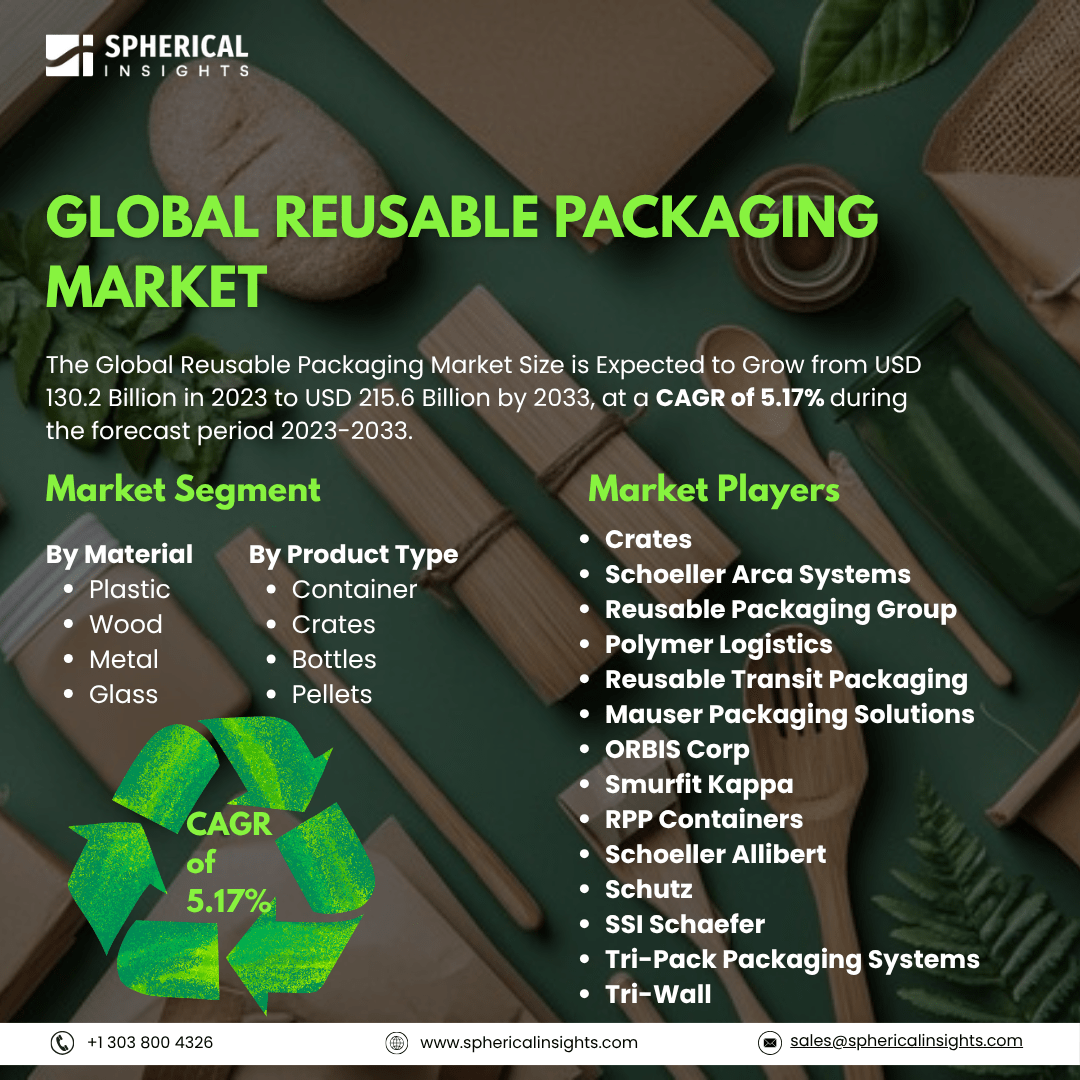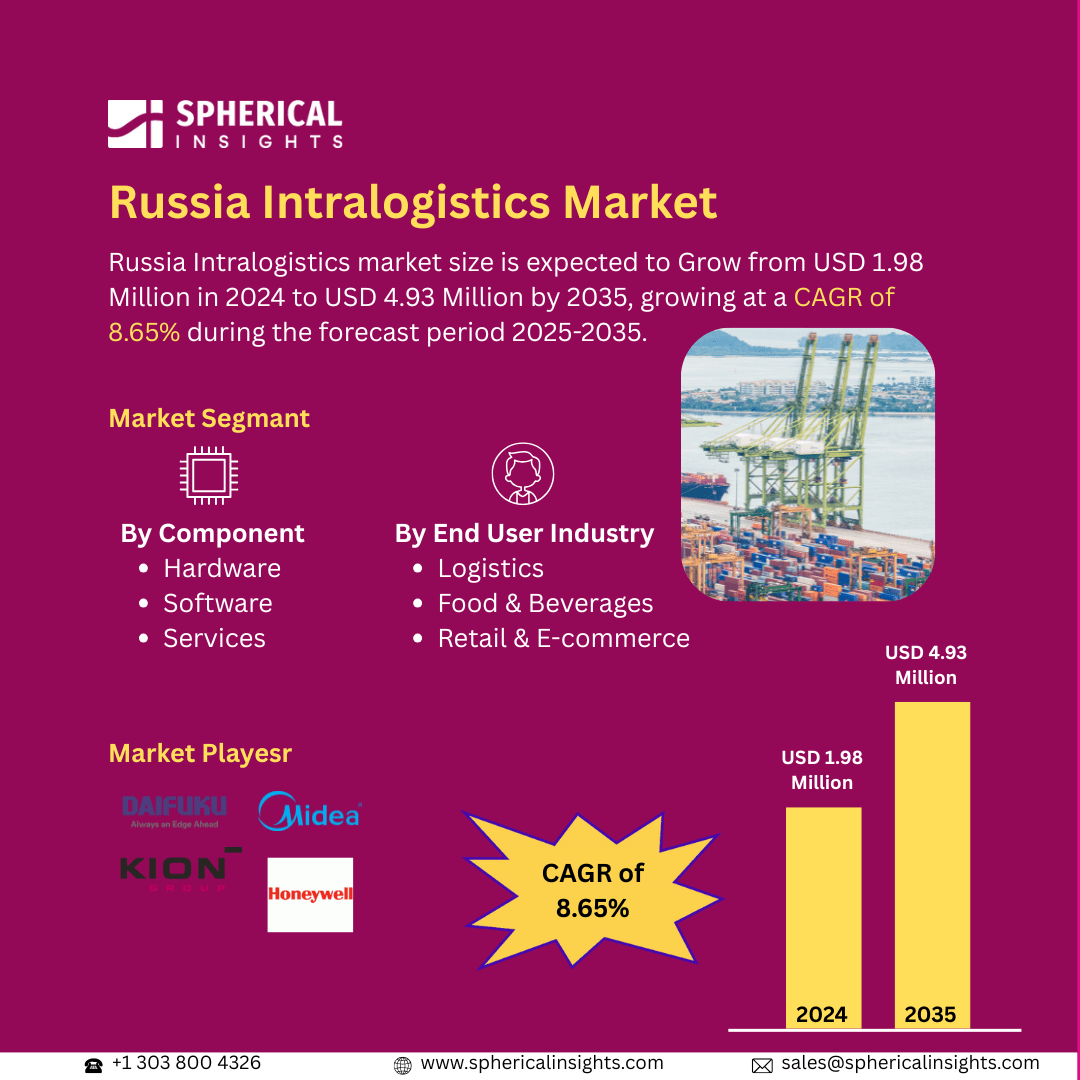Global Reusable Packaging Market Size To Exceed USD 215.6 Billion by 2033
According to a research report published by Spherical Insights & Consulting, The Global Reusable Packaging Market Size is Expected to Grow from USD 130.2 Billion in 2023 to USD 215.6 Billion by 2033, at a CAGR of 5.17% during the forecast period 2023-2033.
Browse 210 Market Data Tables And 45 Figures Spread Through 190 Pages and In-Depth TOC On the Global Reusable Packaging Market Size, Share, and COVID-19 Impact Analysis, By Material (Plastic, Wood, Metal and Glass), By Product Type (Container, Crates, Bottles and Pellets), and By Region (North America, Europe, Asia-Pacific, Latin America, Middle East, and Africa), Analysis and Forecast 2023 - 2033.
The industry and ecosystem surrounding packaging that is made to be used again, usually for the same product or a different purpose after its initial use, is known as the reusable packaging market. This includes systems that allow customers or businesses to return packaging for refills or other uses. It differs from repurposable packaging, which has multiple uses but lacks a structured system for reusing the same item. Packaging that is made and marketed to be used repeatedly, usually by being refilled or used for the same purpose, is referred to as reusable packaging. It is a component of a system that permits this reuse, which frequently includes mechanisms for return and possibly deposit. Globally, governments and regulatory agencies are enforcing strict laws against single-use plastics, which is causing industries to transition to more environmentally friendly substitutes. Reusable packaging is a popular option for companies trying to meet sustainability targets because it drastically lowers waste production, carbon emissions, and resource depletion. Furthermore, the world's infrastructure and urbanization are growing at a rapid pace, and industries need reliable and sustainable packaging solutions for the mass transit of goods. Reusable drums, barrels, and pallets are becoming more and more in demand for industrial, chemical, and construction uses. It is anticipated that the use of reusable packaging solutions will increase significantly as economies make investments in improved supply chain infrastructure and logistics. However, the market for reusable packaging faces a number of obstacles, chief among them being infrastructure, scalability, and consumer acceptance.
The plastic segment dominated the largest share in 2023 and is anticipated to grow at a significant CAGR during the forecast period.
Based on the material, the global reusable packaging market is divided into plastic, wood, metal, and glass. Among these, the plastic segment dominated the largest share in 2023 and is anticipated to grow at a significant CAGR during the forecast period. The durability of plastic is one of the main reasons it dominates the market for reusable packaging. In contrast to metal or glass, which are more likely to break, plastic provides a strong, lightweight structure that can endure repeated use in a variety of industries.
The container segment held the highest share in 2023 and is anticipated to grow at a significant CAGR during the forecast period.
Based on the product type, the global reusable packaging market is divided into container, crates, bottles, and pellets. Among these, the container segment held the highest share in 2023 and is anticipated to grow at a significant CAGR during the forecast period. This is due to their many uses in a variety of industries; containers are the most popular product type in reusable packaging. Containers offer a versatile way to move and store a variety of goods, whether in the food and beverage, automotive, healthcare, or logistics industries.
North America is anticipated to hold the highest share of the global reusable packaging market over the projected period.
North America is anticipated to hold the highest share of the global reusable packaging market over the projected period. Growing environmental concerns and strict government regulations have led to a major push toward sustainable and reusable packaging solutions in North America, especially in the US and Canada. Policies are being put in place by the federal and state governments to lessen the use of single-use plastics, support recycling efforts, and advance circular economy projects.
Asia Pacific is estimated to grow at the fastest CAGR in the global reusable packaging market during the forecast period. This is because of rising middle-class consumption, rapid urbanization, and strict government regulations against plastic waste. As part of their environmental pledges, nations like South Korea, Japan, and India are investing in environmentally friendly packaging options. The demand for robust, economical, and stackable reusable packaging in logistics and warehousing is being driven by the region's dominance in manufacturing, food exports, and cross-border trade.
Company Profiling
Major vendors in the global reusable packaging market are Smart Crates, Schoeller Arca Systems, Reusable Packaging Group, Polymer Logistics, Reusable Transit Packaging, Mauser Packaging Solutions, ORBIS Corp, Smurfit Kappa, RPP Containers, Schoeller Allibert, Schutz, SSI Schaefer, Tri-Pack Packaging Systems, and Tri-Wall, and others.
Key Target Audience
- Market Players
- Investors
- End-users
- Government Authorities
- Consulting and Research Firm
- Venture capitalists
- Value-Added Resellers (VARs)
Market Segment
This study forecasts revenue at the global, regional, and country levels from 2023 to 2033. Spherical Insights has segmented the global reusable packaging market based on the below-mentioned segments:
Global Reusable Packaging Market, By Material
Global Reusable Packaging Market, By Product Type
- Container
- Crates
- Bottles
- Pellets
Global Reusable Packaging Market, By Regional
- North America
- Europe
- Germany
- UK
- France
- Italy
- Spain
- Russia
- Rest of Europe
- Asia Pacific
- China
- Japan
- India
- South Korea
- Australia
- Rest of Asia Pacific
- South America
- Brazil
- Argentina
- Rest of South America
- Middle East & Africa
- UAE
- Saudi Arabia
- Qatar
- South Africa
- Rest of the Middle East & Africa



